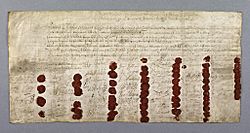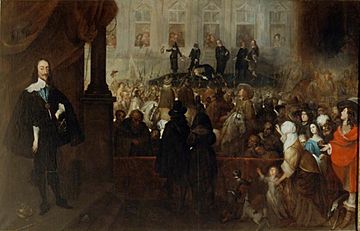John Hewson (regicide) facts for kids
Quick facts for kids
John Hewson
|
|
|---|---|

Death warrant of Charles I; Hewson's signature is bottom of the fourth column from the left
|
|
| Committee of Safety | |
| In office October 1659 – December 1659 |
|
| Member of Parliament for Guildford |
|
| In office September 1656 – January 1658 |
|
| Member of Parliament for County Dublin |
|
| In office September 1654 – January 1655 |
|
| Nominated to Barebones Parliament as MP for Ireland | |
| In office July 1653 – December 1653 |
|
| Governor of Dublin, Ireland | |
| In office September 1649 – October 1656 |
|
| Personal details | |
| Born | Unknown London |
| Died | 1662 Amsterdam, possibly Rouen |
| Spouses | Twice married, unknown |
| Children | Possibly three sons |
| Occupation | Shoemaker, soldier, politician and religious radical |
| Military service | |
| Allegiance | Parliamentarian |
| Years of service | 1642–1659 |
| Rank | Colonel |
| Battles/wars | |
Colonel John Hewson (died 1662) was a shoemaker from London who became a powerful soldier and politician. He fought for the Parliament and the Commonwealth during the Wars of the Three Kingdoms. He rose to the rank of colonel in the army.
Hewson was a strong supporter of Oliver Cromwell in the New Model Army. His soldiers played a key role in important events. He signed the death warrant for King Charles I in 1649. His soldiers also helped keep order during the king's trial and execution.
After the king's death, Hewson served as Governor of Dublin in Ireland. He was also a MP for County Dublin. Later, he returned to England and became an MP for Guildford. He was even made a "Lord" in Cromwell's special Parliament.
When the king's son, Charles II, returned to power in 1660, Hewson had to flee. He was one of the "regicides," meaning he had been involved in the king's death. He went into exile in the Dutch Republic and likely died in Amsterdam in 1662.
Contents
Early Life and Beliefs
Very little is known about John Hewson's early life. We know he worked as a shoemaker in Westminster, London, in the 1620s and 1630s. Records show he sold shoes to the Massachusetts Bay Company in 1628. This suggests he was born before 1604, as he needed to be at least 24 years old to do this.
Hewson later said he grew up in a "wicked family" in London. He found his religious beliefs through a preacher. He was sometimes called an Anabaptist. This was a religious group with strong beliefs that were sometimes seen as radical.
Hewson was married twice. His first wife died in Dublin in 1652. He quickly remarried, but the names of his wives are not known. It is also unclear if he had any children, though some sources mention three sons.
Fighting in the Civil War
Before the First English Civil War began in 1642, Hewson likely served in the local London army. He then joined the Parliamentarian army. He became a captain in 1642.
In 1643, he moved to another army group. By March 1644, he was a Lieutenant colonel in a new infantry regiment. This unit fought in major battles like Marston Moor and Second Newbury.
In 1645, his regiment joined the New Model Army. This was Parliament's main fighting force. Hewson became Lieutenant Colonel of his regiment. Many officers in his unit shared his strong religious views. Parliament was sometimes worried about these radical ideas.
Hewson was known to be very close to Oliver Cromwell. His regiment was famous for its religious devotion. Hewson fought at the Naseby in June 1645. He then helped capture Royalist strongholds in the southwest of England. These included Sherborne Castle, Bridgwater, and Bristol.
While besieging Exeter, his commanding officer died. Hewson then became the colonel of the regiment. His unit helped besiege Oxford, which was the Royalist capital. Oxford surrendered in June 1646, ending the First Civil War. During this time, Hewson preached in a local church, which was against the rules.
Second Civil War and Ireland
Even after winning the First Civil War, there was still tension. Parliament and the army had different ideas about the country's future. Soldiers were owed a lot of money, and the economy was struggling. Hewson helped represent the army in talks with Parliament about their pay.

The Second English Civil War started in 1648. Hewson helped put down a rebellion in Kent. He was praised for his bravery at the storming of Maidstone. This new fighting convinced Cromwell and others that King Charles I needed to be removed.
Hewson played a big part in this decision. His regiment supported Pride's Purge in December 1648. This was when Members of Parliament who opposed putting the king on trial were removed. In January 1649, Hewson served on the court that approved the king's execution. He signed the death warrant. Soldiers from his regiment provided security during the trial and execution.
Hewson was strict about army discipline. In May 1649, 300 men from his regiment refused to go to Ireland. They were quickly dismissed. Hewson then helped Cromwell stop another army rebellion. In August, he arrived in Ireland with Cromwell's forces. He was present at the Siege of Drogheda.
Soon after, Hewson became Governor of Dublin. He also helped relieve Arklow and participated in the Siege of Kilkenny in March 1650. During this siege, he lost an eye.
Life After the King's Death
After the capture of Clonmel in May 1650, Cromwell returned to England. Hewson remained Governor of Dublin. He joined a religious group there led by a preacher named John Rogers. This put him at odds with many officials in Dublin.
In 1652, Hewson was called back to London for discussions. He was chosen as an MP for Ireland in the 1653 Barebones Parliament. He supported the idea of dissolving this Parliament. He also backed Cromwell becoming Lord Protector, even if he was hesitant at first.
Hewson returned to Ireland and was elected MP for County Dublin in 1654. However, he later had disagreements with Henry Cromwell, Oliver Cromwell's son. In 1656, Hewson was ordered back to England. He then represented Guildford in Parliament. He opposed the idea of offering Cromwell the crown.
In 1658, Hewson was made "Lord Hewson." He took a seat in Cromwell's Other House. This was a new body similar to the old House of Lords. Some people were surprised that a man from humble beginnings like Hewson was given such a high position.
Oliver Cromwell died in September 1658. His son, Richard, became Lord Protector. But Richard struggled to control the different groups in the army and Parliament. He resigned in May 1659, ending the Protectorate.
Hewson was appointed commander of the infantry in Ireland. But he was back in London by October. He became a member of the Committee of Safety. This group was set up by the army to control Parliament. In December, Hewson was ordered to stop protests in London. Several people were killed during these events. This led to the committee losing its power, and Hewson was removed from his command.
By April 1660, the king was about to return to power. People like Hewson, who had been involved in the king's execution, faced arrest. Hewson escaped to Amsterdam in May 1660. He is believed to have died there in 1662. However, some sources suggest he might have died in Rouen in 1663.
Images for kids



